Perhaps no ornamental was championed as much as the Pineapple Guava. However the perfect shrub for many places never really caught on. There could be many reasons. It probably didn’t help that a close relative, the Strawberry Guava, is a severe invasive species in some locations. The shrub also does not get showy. You even have to look for the showy blossoms. While the entire blossom is edible most people only eat the petals. Five or six months from now they will be dark green fruit that never change color as they ripen. They just get softer. The shrub is easy to identify when in blossom. To read more about both guavas, go here.
The learning never stops. There is a local semi-parasitic plum, the Tallow Plum or Hog Plum (there are so many “hog” plums we might as well stay with Tallow Plum.”) When bright yellow ripe the plums are tangy but rather sparse. Over the years I have found them three times, all on the east coast of Florida, in the fall, all in hot, sandy places. These were on the south side of Haulover Canal, just north of the space center, at the Enchanted Forest, a park in Titusville, FL, directly west of the space center, and about 120 farther south near Port St. Lucie in the George LeStrange Preserve. All east coast, all in the fall, all in dry, sandy environments, commonly called scrub. Two times there were very low-growing and the third not tall at all.
This Saturday past I had a foraging class in Redbug Sough in Sarasota. It’s coastal but fresh water damp, lots of shade. During the class a student asked “what this?” It was a yellow green fruit with a large stone inside. As in the article below, location is so important to identification. I was flummoxed for a few moments until I thought of Tallow Plum, and a subsequent check showed that’s what it was and that it does grow in that area of the state. I had to expand the descriptors. Hot, sandy, east coast, fall had to change though I suspect the fruit was a fall left over. But now I know where there is one on the west coast, in a humid, shady area. To read more about the Tallow Plum, go here.
Foraging is more than identifying edible wild plants. It also involves knowing how to cook them, when they are prime to harvest, and subject of this review, where to find them. In real estate the mantra is “location, location, location.” We could use that with plants but a refinement would be “environment, environment, environment.”
We know not to look for swamp plants in a desert, unless there is an isolated spring there such as an oasis. Likewise, few cactus grow in swamps though there are exceptions. We also usually find salt tolerant plants near the shore or inland near salt licks (and sometimes along northern roads salted every winter.) But some of those salt-tolerant plants will grow in your garden and do not need to be in a salty environment. Sea Purslane is found on the shore or near brackish water where its job is to build soil by forcing the wind to slow down and drop sand. But, it will also grow in your garden, no salt or wind needed. Other plants are more picky and won’t grow well if not in their preferred location.
For example, one species I am long-familiar with is Blueberries. They like soil on the acidic soil, a pH below 7 on a 14-point scale. I grew-up in poor-soil Maine where one could find 120-acre fields of nothing but Blueberries. Yet where I live now, in Florida, Blueberries are found in small colonies in isolated pockets. Why? One answer is Florida is a limestone plate (alkaline not acidic) so it is a waste of time to look for Blueberries unless there are acid-producing pines, oaks or perhaps cypress nearby. I planted Blueberries specifically bred for Florida but one has to tend to the soil — the amount of acid — nearly as much as one has to work daily to keep a pool from turning green. They eventually died, one of my few failures.
Another example is Dandelions. I have observed for several decades that Dandelions don’t like Florida, or at least the areas of Florida I visit. They like acidic soil. It might be it is not Florida’s heat they don’t like but rather the alkaline (“sweet”) soil. The few places I have seen Dandelions growing have been areas of acidic soil. Dreher Park in West Palm Beach is a good example. What Dandelions there are there can be found growing in lawn grass amongst oaks. With that in mind let’s survey some plants and what soils and conditions they like.
Some plants can do well in nearly any soil. Henbit, Dead Nettle and Shepard’s Purse are good examples. However, the close relative of Shepard’s Purse, Poor Man’s Pepper Grass, likes soil on the alkaline side. This means you probably won’t find Pepper Grass near Pines and Oaks. Plants that like acidic soil (below a pH of 7.0) and you can find near Oaks and Pines include Eastern Bracken Fern, Curly Dock, Mullein, Nettles, Violets, Pineapple Weed, Plantagos, Wild Radish, Sheep Sorrel, Sow Thistle, and wild Strawberries. Plants that like it on the “sweet” or alkaline side besides Pepper Grass? Wild Carrots, Lamb’s Quarters, Amaranth, Pokeweed, White Mustard, and Purslane. Don’t look for those in an oak scrub.
Besides the pH of soil the kind of soil can make a difference. Chicory likes “heavy” soil meaning lots of clay, or rocks. Also liking heavy soil is Broadleaf Dock, Daisies, Milkweed, Plantains, true Thistles, and Wild Garlic. Plants that can endure hard packed soil include Field Mustard, Morning Glories — some of which are edible — and Pineapple Weed (it used to grow in our gravel driveway.) Going the other directions, plants that like sandy soil include Goldenrods and Sandspurs. Plants too look for in agricultural soil include chickweed, Dandelions, Lambs Quarters, Plantains, Amaranth and Purslane. And while Florida Betony can grow edible roots in rich loam or sand it tends to grow larger and easier to harvest roots in sand.
By their very presence some plants can tell you about what’s in or not in the soil. Burdock likes soil very high in iron and sulfate but low in calcium and manganese. Chickweed and Dandelions like low-calcium low-phosphorus soils. Crabgrass likes very low levels of calcium, phosphorus but high levels of chlorine, magnesium and potassium. Oxalis and Hop Cover, however, prefer low levels of calcium but high levels of magnesium. Purslane and Mustard like high phosphorus levels.
If you see a healthy patch of White Clover you know the soil is lacking in nitrogen. Or said another way, you won’t find happy White Clover in nitrogen-rich soil. I suspect that holds true for other members of the pea family as well. Because of preferences you will usually not find amaranth and clover growing together. Red Clover, however, prefers to grow in areas of soil high in potassium. Wild Garlic also likes high potassium as well along with high leaves of chlorine, magnesium, and sodium.
Knowing where to look can increase your chances of finding and identifying wild edibles.
My upcoming foraging Classes:
Saturday, April 18th, Spruce Creek Park, 6250 Ridgewood Ave. Port Orange, FL, 32127, 9 a.m.
Sunday, April 19th, Florida State College, south campus, 11901 Beach Blvd., Jacksonville, FL, 32246, 9 a.m.
Saturday, May 2nd, George LeStrange Preserve, 4911 Ralls Road, Fort Pierce, FL, 34981. 9 a.m.
Sunday, May 3rd, Mead Garden, 1500 S. Denning Dr., Winter Park, FL 32789. 9 a.m.
To learn more about the foraging classes go here.
Need to know a wild tea? Looking for a foraging reference? Maybe you have a UFO, an Unidentified Flowering Object, you want identified. On the Green Deane Forum we chat about foraging all year long. And it’s not just about warm-weather plants or just North American flora. Many nations share common weeds so there’s a lot to talk about. There’s also more than weeds. The reference section has information for foraging around the world. There are articles on food preservation, and forgotten skills from making bows to fermenting food. Recent topics include: Top Restaurant Serves Deer Moss, Uvularia sessilifolia? Where Have You Found Currants? Purple flowering plant ID, Bee Swarms, To Cook is Human, Can I get Some Suggestions, Making Butter, Heliculture, Tincture? What Kind of Weeds? Sassafras, Cherry Bark Tea, Biting Bugs, Firebow Tinder, Sheep Sorrel, Brown Bear and Greens, Homemade Sauerkraut, Coconut Oil, and What Do You See #22. You can join the forum by clicking on the button on the upper right hand side of this page.
What do you see #23. In this photo there are four edible species and one deadly species. Photo by Green Deane.

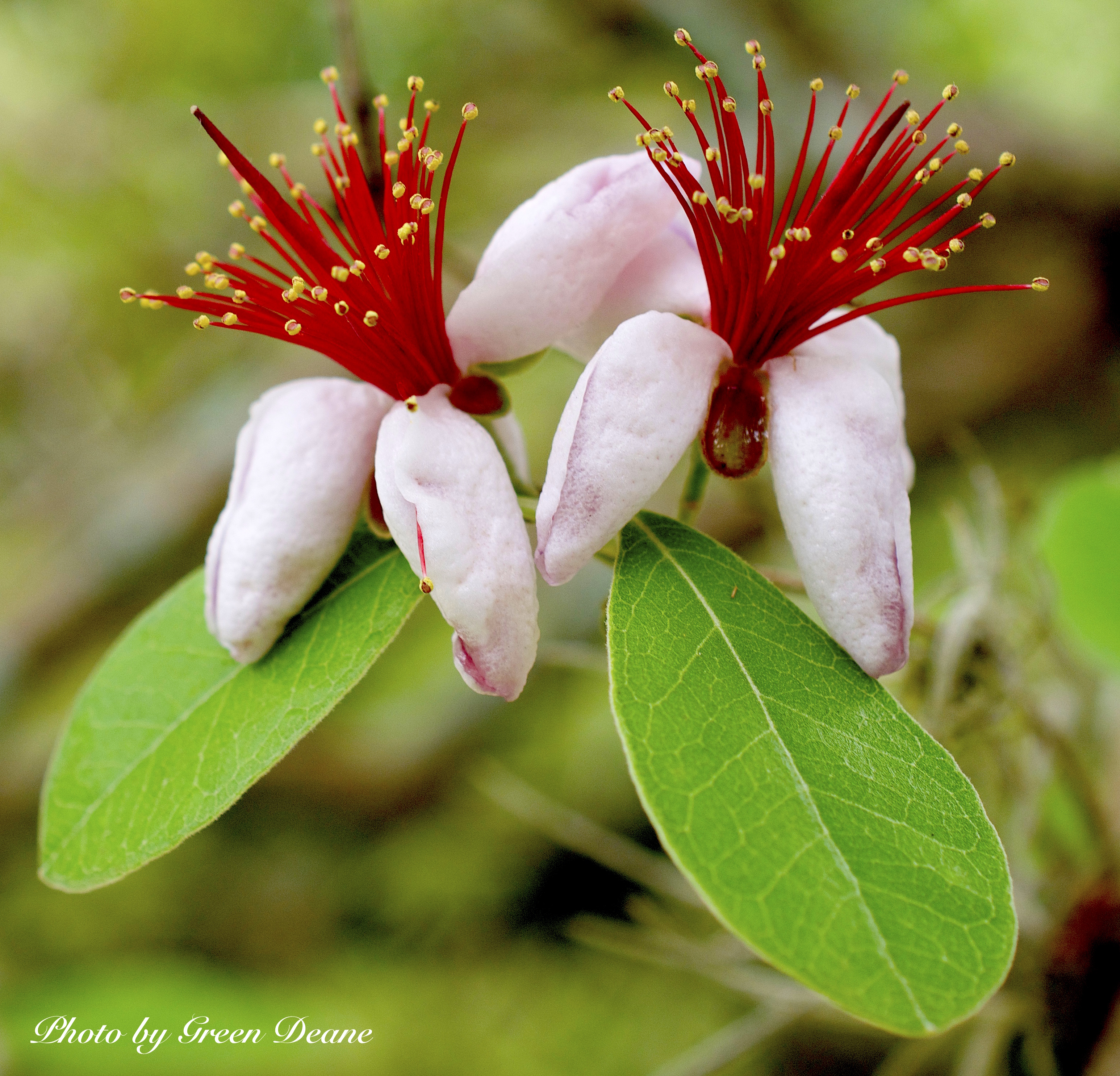
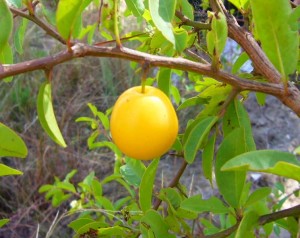

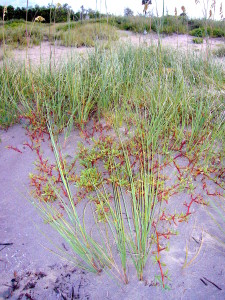
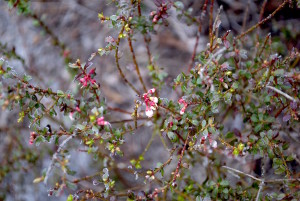
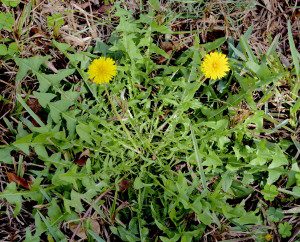
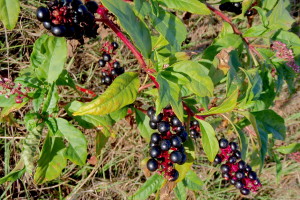
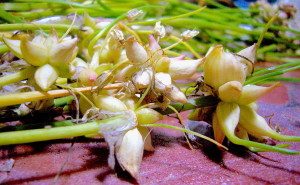
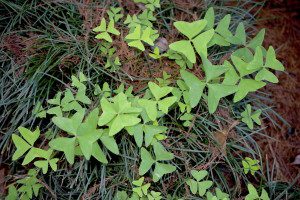
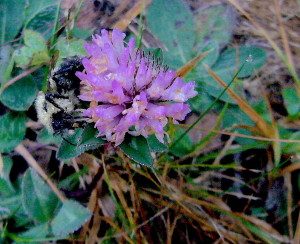
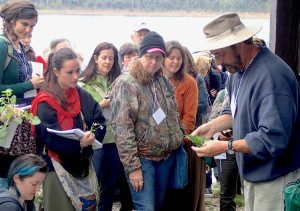
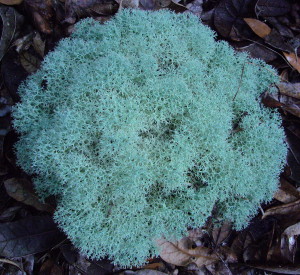
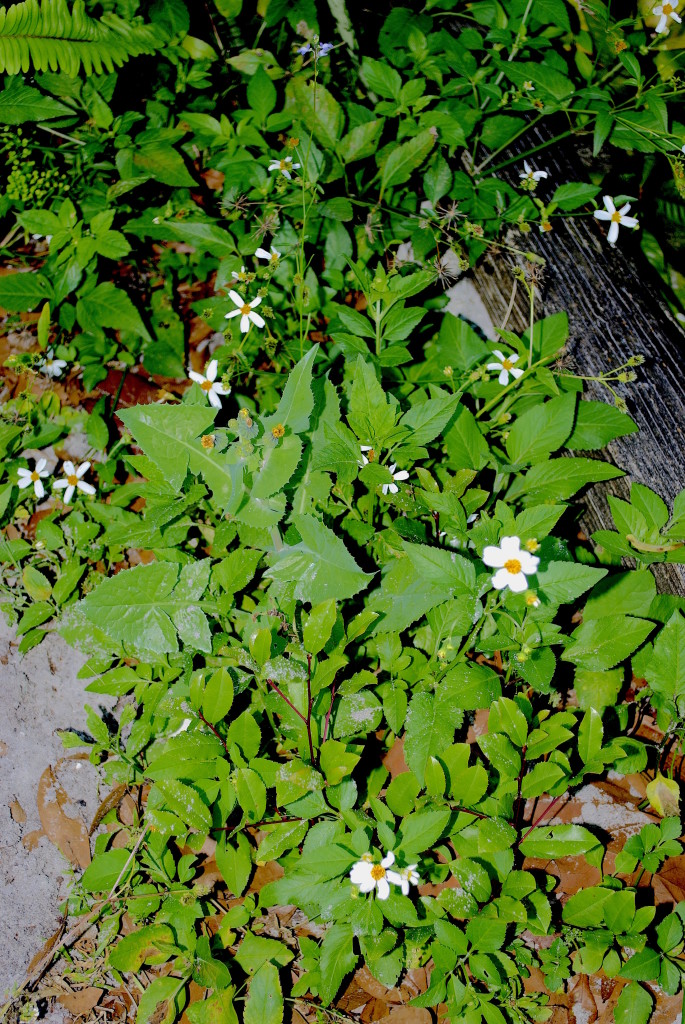

When I was about 12 we lived in the Bear Lake area East of Apopka amidst citrus groves and a lot of wild land before the Disney boom came to central Florida. I always had an interest in gardening and foraging and experimenting with different plants. We visited Sanibel Island one summer and I was intrigued by the mangroves. I dug up a few small plants and planted them beside our home where there was a damp area beside a water fuacet. My father said they would never grow in a non-salt environment, but they did grow and every now and then I would mix a little salt in a bucket of water and pour around the roots. When the leaves began to yellow my grandfather, an old farmer, told me the plants needed magnesium and to add epsom salts (Magnesium Sulphate) with the salt. The plants grew well for several years though they never really flourished. Nothing else grew around thm including grass or weeds because of the salt. We moved away and I never knew what became of my mangroves. I find it enjoyable to try to replicate plant environmnts and experiment. Sometimes I think nature does a little experimenting of its own. Incidentally, we seemed to have milder winters in the 1960’s and 70’s so the mangroves made it through several winters unscathed.
I have a “pet” red mangrove that I planted near my house, too. I brought a propagule home from the Gulf Coast. It has been doing fine. This is its 3rd year. I planted it near the house in some heavy organic soil so I could watch it and enjoy it, although this really not the best place for it. I may transplant it someday. I definitely want to plant a few more (red, black, and white) when I pick an accessible location with the right conditions. If I ever decide to introduce salinity to my “pet” mangrove(s), I would just haul some seawater from the Gulf, which is 20 miles from me. So far, it has not been necessary. I worked in South Florida mangrove swamps doing research for two summers, and they tolerate a wide variety of conditions. Mangroves thrive at least as far north as Cedar Key on the Gulf Coast.
Edible: Spanish needles, dandelion, fern possibly?
Spanish needles, yes, and the sword fern… that leaves four to go.
Sow thistle
Sowthistle in the middle which is known as Puha by the Maoris in New Zealand, grows well in Sydney also.
I think I see sow thistle, an edible.
sow thistle?
John S
Chickweed, dandelion, wild strawberry, Spanish needles, poison ivy
The Spanish Needles is right…
My fave weed, Bidens alba, my unplanted garden gift with pretty flowers to boot. I keep a small patch to eat, and pick the flowers to keep the beggar ticks from snagging on everything. Sow thistle…sword fern and not sure what the red stemmed plant is nor the little purple flower. or the stalk the the right of that that looks like it may have a flower bud? Spill Deane!
Blackberry’s
If you mean What Do You See #23 there are no blackberries in the photo.
Sorry, thought There was blooms and little green berrys until I blow it up larger. They are blooming here in Alabama. What are the blooms ? I’m very new to foraging anything other than fruit. Thanks for all your newsletters.
It’s true. Almost no salt water plants require salt to grow (there are one or two exceptions). The reason you don’t see marsh plants popping up in your front lawn is they are out competed by other plants. They rely on salt to kill competing species of plants.
I like the points raised in the review on where to find edibles. In my country Sesame (Sesamum alatum ) grows happily in Gedarif clay soil . This made Sudanese people to rejoice and sing a famous local song named, “Sesame elGadarif” – the city is now the capital of a rich state producing sesame and sorghum – dura . Pearl millet (Pennisetum glaucum) and pea nuts flourish very much in the “Quoz sands” of western Sudan. It is the same area from which gum Arabic is obtained by tapping of “Hashab – local for Acacia Senegal” trees. On the other hand, the alluvial soils along the Nile and tributaries are ideal for Cowpea “Vigna anguiculata” . All these soils belong to the acidic side of the pH scale. I must also add ,geologically, that these soils are the results of degradation of igneous and Nubian sandstone.
In the above context, let me close with my prophet’s( peace be upon Him ) analogy : “The guidance and knowledge with which Allah has sent me are like abundant rain which fell on a land – soil – a fertile part of it absorbed the water and brought forth profuse herbage and pasture, a second solid ground patches which retained the water by which Allah has benefited people, who drank from it, irrigated their crops and sowed their seeds and a third sandy plain which could neither retain the water nor produce herbage. Such is the similitude of the person who becomes well – versed in the religion of Allah and receives benefit from the message entrusted to me by Allah; so he himself has learned and taught it to others; such is also the similitude of the person who has stubbornly and ignorantly rejected Allah’s guidance with which I have been sent.”
I see bidens alba, sword fern and a thistle. I dont know what would be the deadly one?
There is a Bidens alba, sow thistle, and a sword fern. The toxic plants have the red stems. That should help ID them.
Hard to see the details on the leaves, best guess is maybe pokeberry but the stems look too skinny, or maybe poison sumac but thats rare.
And the other edible, i see a purple flower in that betony?
The answer is on the Green Deane Forum…. but no red stems are not poke berry but young Cherry Laurels, Prunus caroliniana. And no the purple flower is not edible, it is Canadian Toad Flax.
This seems really interesting. Foraging for food has become something of a lost art. I feel like most people (including myself) would probably die from eating something I shouldn’t have if the time ever came where foraging became a necessity.